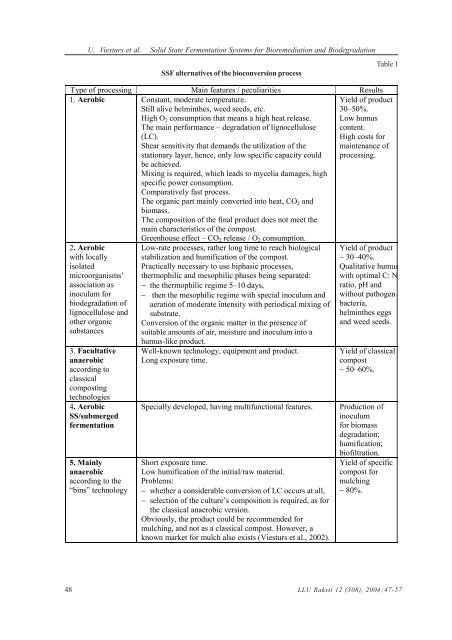saturs - Latvijas LauksaimniecÄ«bas universitÄte
saturs - Latvijas LauksaimniecÄ«bas universitÄte
saturs - Latvijas LauksaimniecÄ«bas universitÄte
- No tags were found...
Create successful ePaper yourself
Turn your PDF publications into a flip-book with our unique Google optimized e-Paper software.
U. Viesturs et al. Solid State Fermentation Systems for Bioremediation and BiodegradationSSF alternatives of the bioconversion processTable 1Type of processing Main features / peculiarities Results1. Aerobic Constant, moderate temperature.Still alive helminthes, weed seeds, etc.High O 2 consumption that means a high heat release.The main performance – degradation of lignocellulose(LC).Shear sensitivity that demands the utilization of thestationary layer, hence, only low specific capacity couldbe achieved.Mixing is required, which leads to mycelia damages, highspecific power consumption.Comparatively fast process.The organic part mainly converted into heat, CO 2 andbiomass.The composition of the final product does not meet themain characteristics of the compost.Greenhouse effect – CO 2 release / O 2 consumption.Yield of product30–50%.Low humuscontent.High costs formaintenance ofprocessing.2. Aerobicwith locallyisolatedmicroorganisms’association asinoculum forbiodegradation oflignocellulose andother organicsubstances3. Facultativeanaerobicaccording toclassicalcompostingtechnologies4. AerobicSS/submergedfermentation5. Mainlyanaerobicaccording to the“bins” technologyLow-rate processes, rather long time to reach biologicalstabilization and humification of the compost.Practically necessary to use biphasic processes,thermophilic and mesophilic phases being separated:− the thermophilic regime 5–10 days,− then the mesophilic regime with special inoculum andaeration of moderate intensity with periodical mixing ofsubstrate.Conversion of the organic matter in the presence ofsuitable amounts of air, moisture and inoculum into ahumus-like product.Well-known technology, equipment and product.Long exposure time.Specially developed, having multifunctional features.Short exposure time.Low humification of the initial/raw material.Problems:− whether a considerable conversion of LC occurs at all,− selection of the culture’s composition is required, as forthe classical anaerobic version.Obviously, the product could be recommended formulching, and not as a classical compost. However, aknown market for mulch also exists (Viesturs et al., 2002).Yield of product~ 30–40%.Qualitative humuswith optimal C: Nratio, pH andwithout pathogenbacteria,helminthes eggsand weed seeds.Yield of classicalcompost~ 50–60%.Production ofinoculumfor biomassdegradation;humification;biofiltration.Yield of specificcompost formulching~ 80%.48 LLU Raksti 12 (308), 2004; 47-57 1-18
















